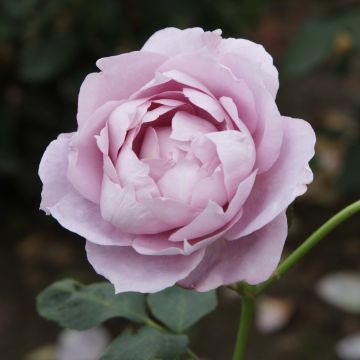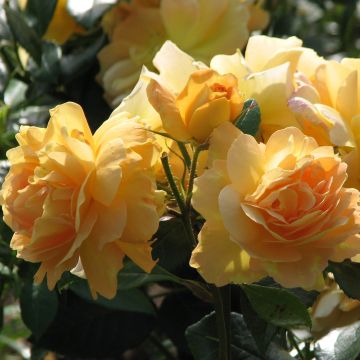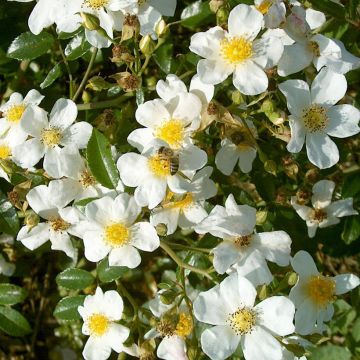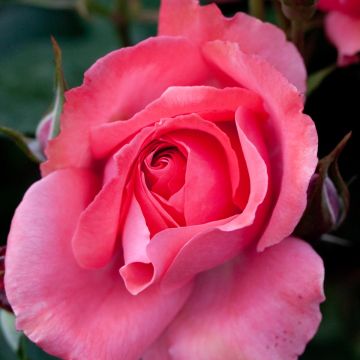

Rosa Rose de Perouges - Climbing Rose
Rosa Rose de Perouges - Climbing Rose
Rosa x grimpant Rose de Perouges ® Laperou
This item cannot be shipped to the selected country
Delivery charge from €5.90
Delivery charge from €5.90
Delivery to Corse prohibited
More information
Schedule delivery date,
and select date in basket
This plant carries a 24 months recovery warranty
More information
We guarantee the quality of our plants for a full growing cycle, and will replace at our expense any plant that fails to recover under normal climatic and planting conditions.
From €5.90 for pickup delivery and €6.90 for home delivery
Express home delivery from €8.90.
From €5.90 for pickup delivery and €6.90 for home delivery
Express home delivery from €8.90.
Delivery to Corse prohibited: UE law prohibits the import of this plant from mainland France to Corse as part of the fight against Xylella fastidiosa. Please accept our sincere apologies.
More information
Does this plant fit my garden?
Set up your Plantfit profile →
Description
The 'Rose de Pérouges' or 'Laperou' Climbing Rose is a modern climbing rose with many qualities: the plant is vigorous and disease-resistant, its foliage is highly decorative and bright green, and its flowering is generous and richly coloured. From June to October, it offers beautiful bouquets of semi-double cup-shaped flowers of medium size in a very bright raspberry red. It is an excellent asset for garden, balcony, and terrace decoration.
The climbing rose 'Rose de Pérouges' is a creation of the Laperriere rose garden in the Lyon region (since 1864). Its name pays homage to a beautiful historic village in Ain. It is currently classified as climbing roses with large grouped flowers. Vigorous and hardy, with rapid growth, it will rise to 3m (10ft), or even 4m (13ft) under optimal conditions, and will spread over approximately 2 m². Like all climbing roses, it can also be trained as a bush by regular pruning. It forms long thorny stems that bear deciduous foliage, a bright medium green, which is not very susceptible to diseases and perfectly enhances the colour of the flowers. It blooms from June to October, provided it has enough water and sunlight. Its semi-double cup-shaped flowers, 6-7 cm (2-3in) in diameter, have about twenty petals. They are grouped in bouquets of 3 to 5 units. The colour of the flowers is a vivid red-pink, slightly fading with grace at the edges of the petals.
With its vibrant flowering, this climbing rose is suitable for gardens of all styles. Choose a wall exposed to the morning sun or a structure large enough to support its shower of flowers. It allows you to create sumptuous decorations throughout the summer, requiring very little maintenance apart from regular watering in summer during periods of high heat and prolonged drought, as well as occasional severe pruning. As a structural element in English-style gardens, rose arches form beautiful shelters where you can rest while connecting different parts of the garden. Mix climbing roses or combine them with easy-to-grow large-flowered clematis such as 'Etoile Violette', Montana Mayleen, or 'Broughton Star'. When allowed to grow freely, 'Rose de Pérouges' forms a superb bush that is also ideal in a sizeable flowering hedge alongside lilacs, tamarisks, or other shrub roses such as R.Californica Plena, R.hugonis, Iceberg, or Madame Isaac Pereire.
Report an error about the product description
Plant habit
Flowering
Foliage
Botanical data
Rosa
x grimpant
Rose de Perouges ® Laperou
Rosaceae
Cultivar or hybrid
Other Climbing Roses
Planting and care
Wait until the months between November and March. Find a spot with deep, well-prepared soil that's not too clayey and has good drainage. The rose prefers fertile soil that's on the heavy side, but not overly compact. If the soil is sandy, compact, or dry in summer, mix in compost or well-rotted manure. Avoid waterlogged soil in winter. Choose a sunny spot with partial shade that's not too hot. Roses need a lot of nutrients, so use a specific fertiliser at the start of growth and during the flowering period. To promote reblooming, remove faded flowers regularly. Prune the stems to a quarter of their length (four to six buds from the base) in late winter. Cut above an outward-facing bud to help branches form and avoid tangling. Floribunda rose varieties are more vigorous and floriferous than large-flowered rose varieties.
Roses may develop unsightly spots at the end of summer, but this is a natural occurrence and doesn't harm the rose's growth.
Planting period
Intended location
Care
This item has not been reviewed yet - be the first to leave a review about it.
Roses by purpose
Haven't found what you were looking for?
Hardiness is the lowest winter temperature a plant can endure without suffering serious damage or even dying. However, hardiness is affected by location (a sheltered area, such as a patio), protection (winter cover) and soil type (hardiness is improved by well-drained soil).

Photo Sharing Terms & Conditions
In order to encourage gardeners to interact and share their experiences, Promesse de fleurs offers various media enabling content to be uploaded onto its Site - in particular via the ‘Photo sharing’ module.
The User agrees to refrain from:
- Posting any content that is illegal, prejudicial, insulting, racist, inciteful to hatred, revisionist, contrary to public decency, that infringes on privacy or on the privacy rights of third parties, in particular the publicity rights of persons and goods, intellectual property rights, or the right to privacy.
- Submitting content on behalf of a third party;
- Impersonate the identity of a third party and/or publish any personal information about a third party;
In general, the User undertakes to refrain from any unethical behaviour.
All Content (in particular text, comments, files, images, photos, videos, creative works, etc.), which may be subject to property or intellectual property rights, image or other private rights, shall remain the property of the User, subject to the limited rights granted by the terms of the licence granted by Promesse de fleurs as stated below. Users are at liberty to publish or not to publish such Content on the Site, notably via the ‘Photo Sharing’ facility, and accept that this Content shall be made public and freely accessible, notably on the Internet.
Users further acknowledge, undertake to have ,and guarantee that they hold all necessary rights and permissions to publish such material on the Site, in particular with regard to the legislation in force pertaining to any privacy, property, intellectual property, image, or contractual rights, or rights of any other nature. By publishing such Content on the Site, Users acknowledge accepting full liability as publishers of the Content within the meaning of the law, and grant Promesse de fleurs, free of charge, an inclusive, worldwide licence for the said Content for the entire duration of its publication, including all reproduction, representation, up/downloading, displaying, performing, transmission, and storage rights.
Users also grant permission for their name to be linked to the Content and accept that this link may not always be made available.
By engaging in posting material, Users consent to their Content becoming automatically accessible on the Internet, in particular on other sites and/or blogs and/or web pages of the Promesse de fleurs site, including in particular social pages and the Promesse de fleurs catalogue.
Users may secure the removal of entrusted content free of charge by issuing a simple request via our contact form.
The flowering period indicated on our website applies to countries and regions located in USDA zone 8 (France, the United Kingdom, Ireland, the Netherlands, etc.)
It will vary according to where you live:
- In zones 9 to 10 (Italy, Spain, Greece, etc.), flowering will occur about 2 to 4 weeks earlier.
- In zones 6 to 7 (Germany, Poland, Slovenia, and lower mountainous regions), flowering will be delayed by 2 to 3 weeks.
- In zone 5 (Central Europe, Scandinavia), blooming will be delayed by 3 to 5 weeks.
In temperate climates, pruning of spring-flowering shrubs (forsythia, spireas, etc.) should be done just after flowering.
Pruning of summer-flowering shrubs (Indian Lilac, Perovskia, etc.) can be done in winter or spring.
In cold regions as well as with frost-sensitive plants, avoid pruning too early when severe frosts may still occur.
The planting period indicated on our website applies to countries and regions located in USDA zone 8 (France, United Kingdom, Ireland, Netherlands).
It will vary according to where you live:
- In Mediterranean zones (Marseille, Madrid, Milan, etc.), autumn and winter are the best planting periods.
- In continental zones (Strasbourg, Munich, Vienna, etc.), delay planting by 2 to 3 weeks in spring and bring it forward by 2 to 4 weeks in autumn.
- In mountainous regions (the Alps, Pyrenees, Carpathians, etc.), it is best to plant in late spring (May-June) or late summer (August-September).
The harvesting period indicated on our website applies to countries and regions in USDA zone 8 (France, England, Ireland, the Netherlands).
In colder areas (Scandinavia, Poland, Austria...) fruit and vegetable harvests are likely to be delayed by 3-4 weeks.
In warmer areas (Italy, Spain, Greece, etc.), harvesting will probably take place earlier, depending on weather conditions.
The sowing periods indicated on our website apply to countries and regions within USDA Zone 8 (France, UK, Ireland, Netherlands).
In colder areas (Scandinavia, Poland, Austria...), delay any outdoor sowing by 3-4 weeks, or sow under glass.
In warmer climes (Italy, Spain, Greece, etc.), bring outdoor sowing forward by a few weeks.























































